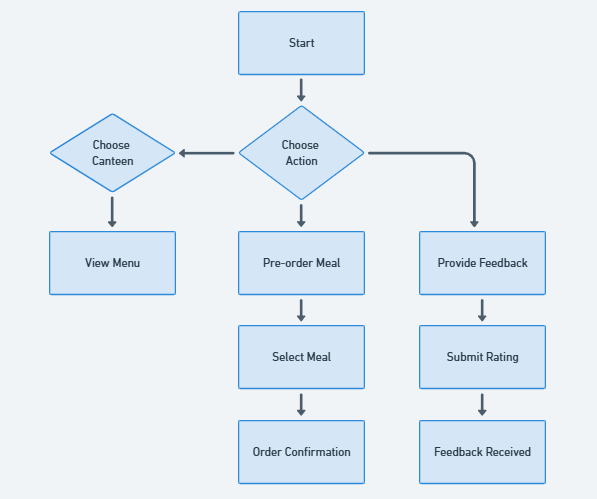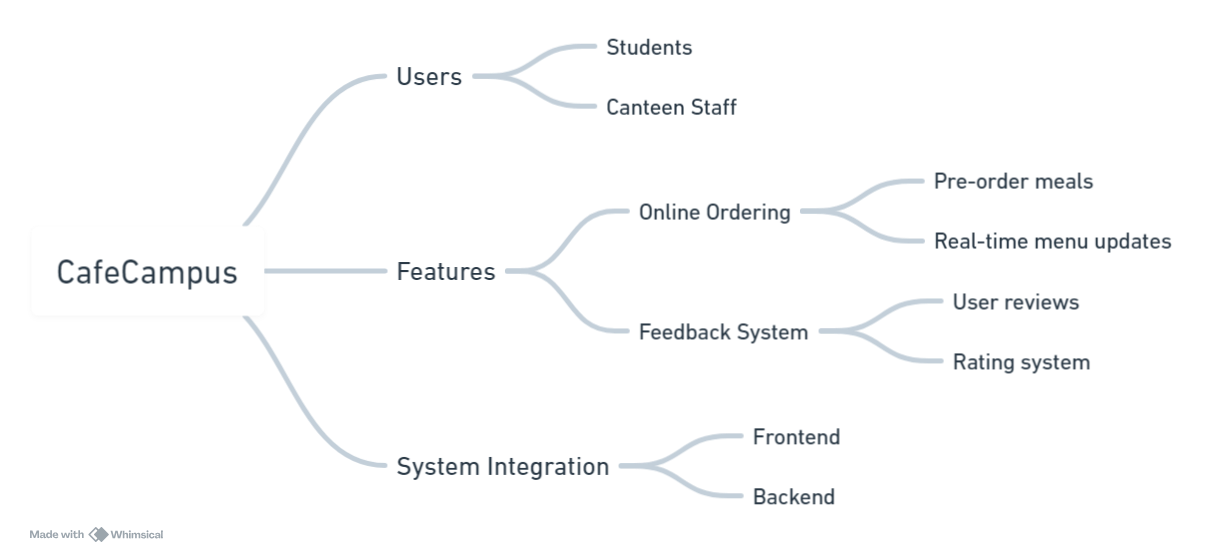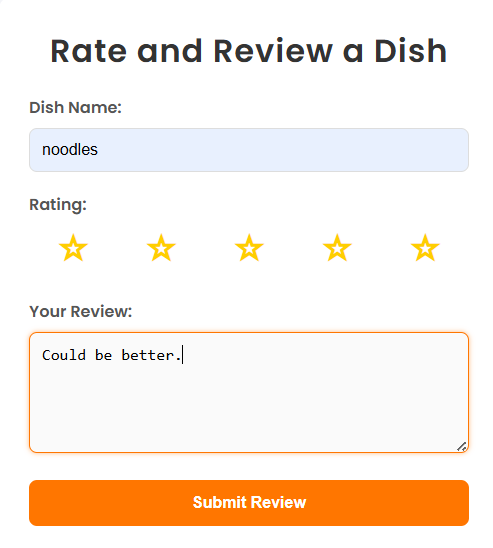Ijraset Journal For Research in Applied Science and Engineering Technology
- Home / Ijraset
- On This Page
- Abstract
- Introduction
- Conclusion
- References
- Copyright
CAFECAMPUS: Smart Canteen Food Rating and Preorder System
Authors: Gouri Karyappa, Shrawan Kumbhar, Dhanshree Biradar, Ralieka Mishra, Shraddha Habbu
DOI Link: https://doi.org/10.22214/ijraset.2024.65576
Certificate: View Certificate
Abstract
CafeCampus is a web-based platform developed to enrich the dining experience within college canteens. This website helps students peruse canteen menus, provide ratings to dishes, and place preorders, which saves them time by allowing them to add menu items to a cart and order their meals in advance. Reviewing food products can help students make informed decisions and help businesses improve their reputation and sales. This has the advantage of allowing users to place online meal orders using CafeCampus in the event if there is a rush in the canteen and the servers are not accessible. Hence, the student can use the mobile application to access their order data and order status updates. Through CafeCampus, the canteen oversees the management of the students\' orders and provides regular updates on their progress. Administrators oversee students and cafeteria via the internet program. With its user-friendly interface, the software lets users easily navigate menus, choose from a variety of cuisine options and easily tailor their orders and also review it after their dining.
Introduction
I. INTRODUCTION
An innovative digital solution called CafeCampus is set to transform the conventional canteen experience in educational institutions. Today's fast-paced world demands prompt and effective service for the general public in all spheres of life. Serving students quickly at billing counters is necessary since they frequently utilize the cafeteria and eating facilities at their places of academic institutions. The goal of this effort is to create an effective smart canteen Food Rating and Preorder System. Long lines, a small selection of menu items, and slow payment procedures are common problems with traditional canteen systems, which frustrate patrons and waste time for canteen employees. In order to pay for meals within a set break period, students and faculty members must currently stand in line at school canteens. However, this leads to problems because everyone rushes to the canteen at the same time, which infuriates the staff and students alike. In addition, some students might not be able to eat or might wind up wasting their food because of time constraints. The CafeCampus web platform was created to solve these issues and improve workflow.
II. LITERATURE SURVEY
This section reviews existing research on Canteen Management, highlighting significant developments and identifying areas where further work is needed.In recent years, studies on canteen management have primarily focused on ordering and payement. These works provide a foundation for exploring the review of the student as well so that the canteen staff gets a brief idea about student needs.
Sujata Joshi et al. (2022) presents a smart Canteen Mangement System. This System in addition to automatically debiting when balance is low, it also suggests using radio frequency identification to identify and authenticate individuals in order to grant access [1]. However , it lacks a feedback mechanism which is essential to understand the students needs.Ashish Sahoo et al. (2023) introduces a multi-purpose smart automat which offers multi operations such as discount offers, employee identification and sitting allocation for a college canteen [2]. Although it is effective in providing sittting allocation, it is limited to pre-order meals from college canteen.S.T.F Toma et al. (2021) developed an automated canteen management system using a NodeMCU, RFID reader and RFID tags that will make ordering and paying for food at any canteen [3] . However , the solution lacks a reviewing system which is important for intrepreting the student preferences.
Lalitha V. et al. (2022) propose a web application to order food online from a particular canteen. Despite its benefits, the lack of a feedback system limits it’s ability to gather user opinions and improve service quality based on customer satisfaction [4].Prathmesh Auti et al. (2023) propose a Smart canteen app enable customers to conveniently browse menus, place orders, and make payments [5] . While effective in placeing orders ,the system does not have a response mechanism. This restricts it’s potential to assess customer satisfaction, address issues promptly, and make improvements based on user experiences.
We also referred to the work of Lourrso N. et al. (2020) to have a better understanding about students dining experince [6] .In similar vein , H.B. Patil et al. propose a system which aims to remove the hassle of cash transactions from college canteen payments by streamlining the process. The present reliance on currency frequently proves inconvenient, particularly when precise amounts are needed, making change provision difficult [7]. One study examines a application which is used to improve the canteen . Using this application, canteens can take the order and people can order food online using sites, once they have paid for food, they can get the order id or booking id [8]. Another study in similar way, propose an automated system which surpass the current hassle by an automated web based system which will maintain, manage and process orders of customers in a speedy way using a website and its stored database [9].
To address the shortcomings of the current methods, this research offers a more user-friendly and interactive user interface (UI) that includes a feedback mechanismand apre-ordering system. By incorporating student feedback on the quality of food and dining services, CafeCampus can use real-time ratings and reviews to help improve canteen offerings. This creates a feedback loop that directly impacts service quality.
III. METHODOLOGY
A. Flowchart and Mindmap

Fig.1 Project Methodology
 Fig. 2 Mind map
Fig. 2 Mind map
???????B. Method
We applied the five stages of design thinking to develop CafeCampus. The first stage was Empathize which involved conducting surveys to identify key challenges faced by users. One prominent issue that emerged was the long wait times during peak hours. To enhance decision-making and streamline the dining experience, students expressed the need for a system that would allow them to preorder food and access reviews, helping them save time and make informed choices.
Second stage was to Define: Our conclusion was that "Students struggle with long queues and a lack of accessible menu information, leading to a subpar canteen experience." This brought to light the requirements we needed to meet for our users, such as cutting down on wait times with an effective preordering system, adding a dish rating system to improve the quality of the food, and making menu information and daily specials easily accessible. As a result, our project goal was to develop a comprehensive website for college canteen meal rating and preordering. Third stage was to Ideate: The suggested remedy entails creating an extensive website intended to improve the eating experience. The platform will allow customers to examine comprehensive menus, choose their favourite canteen, and use a meal rating and feedback system that offers insightful information about various dishes. A built-in preordering system will also be available on the website, enabling customers to place purchases ahead of time and cutting down on wait times. The platform will draw attention to daily specials and make sure they are easily accessible in order to further improve the user experience. The goal of this feature set is to facilitate dining and encourage wise decision-making. We produced a preliminary design during the prototype phase that prioritized both usability and functionality. Important elements including food reviews, a preorder system, thorough menu displays, and canteen selection were all built into the UI. To guarantee a smooth and user-friendly experience, we used Figma to build an intuitive user interface (UI). PHP and XAMPP were used concurrently to put up the backend architecture for effective local development and testing. A search bar for simple navigation, a strong rating system for user input, and a handy cart system to enable preordering are some of the key elements included in the prototype.
???????C. Testing
In the Testing phase, we adopted a comprehensive and methodical approach to assess the prototype's functionality, usability, and overall user experience. Our process began with conducting extensive user testing, actively involving both students and staff to evaluate the system in realistic scenarios. By simulating peak-hour conditions and typical usage patterns, we gained a deeper understanding of how the platform would perform under varying circumstances. To capture diverse perspectives, we collected detailed feedback through structured surveys, one-on-one interviews, and observational studies. These methods helped us uncover critical insights into users' experiences, satisfaction levels, and pain points. We paid particular attention to aspects such as ease of navigation, effectiveness of the search functionality, and the efficiency of the preorder system. The feedback received was meticulously analysed, highlighting areas that needed refinement or enhancement. This iterative process allowed us to address identified issues proactively, making necessary adjustments to the user interface, backend functionality, and overall design. By continuously testing and improving the prototype, we ensured that the final solution was not only robust and reliable but also intuitive and aligned with user expectations. This thorough testing phase was crucial in delivering a polished, user-centered platform that effectively meets the needs of the CafeCampus community.

Fig 3: Menu Access
The above image displays a cafeteria menu showcasing various snack items, each presented with an image, name, price, rating, and a "Pre-Order" button. The layout is structured in a grid format, allowing users to easily view and select their desired food items (Fig 3).

Fig 4: Feedback form
The image shows a "Rate and Review a Dish" interface where users can provide feedback on cafeteria items. It includes a field for the Dish Name (in this case, "noodles") and a star rating system, allowing users to rate the dish on a scale of 1 to 5 stars. Below the rating, there's a text box for users to write a detailed review, with the example input stating, "Could be better." Finally, there is a prominent "Submit Review" button at the bottom, enabling users to submit their feedback. This feature promotes user engagement and helps others make informed choices based on peer reviews (Fig 4).

Fig 5: Preorder form
The above image shows a Preorder Form of our website for placing an order at a canteen. The customer,( named Gouri) has selected the cafeteria as the canteen. They can choose a dish of their choice and can also mention the quantity, the total price will be displayed .The order can be scheduled based on student preferences. The student can also add any special requirements like making the dish less spicy or toppings of their choice. There are also options to "Add to Cart" or "Order Now" at the bottom (Fig 5).
IV. RESULTS
The Canteen Food Rating Website was tested by 50 students during the trial phase. Over the course of 4 weeks, a total of 200 food items were rated, with an average rating of 4.2 out of 5 for taste and 4.5 for hygiene. Students provided an average of 3 reviews per week, demonstrating active engagement with the platform. Feedback from students highlighted that the rating system led to noticeable improvements in food quality, as canteen staff responded promptly to suggestions related to taste, portion sizes, and cleanliness. In particular, students noted that the staff had made adjustments to improve food hygiene and consistency after receiving feedback.
The preordering system resulted in a 30% reduction in wait times during peak hours. Prior to the introduction of the website, students often faced long queues, especially during lunchtime. However, with the ability to preorder, students could collect their food in a more organized manner, significantly reducing congestion. This change in operations not only improved the dining experience but also allowed canteen staff to better manage food preparation, reducing wastage by 15% due to more accurate demand forecasting. Furthermore, 95% of students successfully completed the ordering process without any difficulties, reflecting the platform’s user-friendly design. Overall, 85% of the students surveyed indicated that they found the website to be a valuable tool in enhancing their campus dining experience. The platform’s intuitive interface, combined with its practical features, was well-received, and the majority of students expressed their intention to continue using the website. Additionally, 40% of students suggested the addition of a payment gateway, and 20% requested real-time order tracking features. These insights will be used to guide future updates to the platform.
Conclusion
CafeCampus has been developed to enhance the dining experience in college canteens by offering students a convenient, user-friendly platform to browse menus, rate dishes, and place preorders. By integrating real-time menu updates, personalized recommendations, and a simple ordering process, CafeCampus streamlines the dining process for students while supporting canteen operations. Through continuous feedback and a focus on ease of use, the platform creates a more enjoyable, efficient, and sustainable dining experience for the entire campus community.
References
[1] Joshi, Sujata, et al. \"Smart Canteen Management System.\" 2022 IEEE 2nd Mysore Sub Section International Conference (MysuruCon). IEEE, 2022. Available: https://www.researchgate.net/publication/366239991_Smart_Canteen_Management_System [2] Sahoo, Ashish Kumar, et al. \"A Multipurpose Smart Canteen Management System Using VHDL.\" 2023 1st International Conference on Circuits, Power and Intelligent Systems (CCPIS). IEEE, 2023. Avaliable: https://www.researchgate.net/publication/375053362_A_Multipurpose_Smart_Canteen_Management_System_Using_VHDL [3] Toma, Syeda Tanzina Farhin, et al. \"Canteen Automation System: An Approach for “Smart City” Planning.\" 2021 IEEE Asia-Pacific Conference on Computer Science and Data Engineering (CSDE). IEEE, 2021. Available: https://ieeexplore.ieee.org/abstract/document/9718443 [4] Lalitha, V., et al. \"E-Canteen Management System based on Web Application.\" 2022 International Conference on Communication, Computing and Internet of Things (IC3IoT). IEEE, 2022. [5] Prathmesh Auti, et al. “A review on smart canteen management system.” International Journal for Research in Applied Science & Engineering Technology (IJRASET).Available: https://www.ijraset.com/research-paper/a-review-on-smart-canteen-management-system [6] Lorusso, N., Tanda, A., & Malavasi, F. (2020). \"Evaluating the quality of university food services: A student-centered approach.\" Journal of Hospitality and Tourism Education. [7] Patil, H. B., et al. \"Elevating Canteen Management with a Modern Web Solution.\" 2024 IEEE International Students\' Conference on Electrical, Electronics and Computer Science (SCEECS).IEEE,2024.Available: https://ieeexplore.ieee.org/abstract/document/10482188 [8] Sasirekha, N., K. M. Shreenivas, and N. Swetha. \"Smart Cafeteria.\" Journal of Survey in Fisheries Sciences 10.2S (2023):11201125.Available: https://sifisheriessciences.com/journal/index.php/journal/article/view/802 [9] Avhad, Prashant, et al. \"Canteen automation system with payment gateway.\" Proceedings of the 3rd International Conference on Advances in Science & Technology (ICAST). 2020.Available: https://papers.ssrn.com/sol3/papers.cfm?abstract_id=3568597
Copyright
Copyright © 2024 Gouri Karyappa, Shrawan Kumbhar, Dhanshree Biradar, Ralieka Mishra, Shraddha Habbu. This is an open access article distributed under the Creative Commons Attribution License, which permits unrestricted use, distribution, and reproduction in any medium, provided the original work is properly cited.

Download Paper
Paper Id : IJRASET65576
Publish Date : 2024-11-27
ISSN : 2321-9653
Publisher Name : IJRASET
DOI Link : Click Here
 Submit Paper Online
Submit Paper Online

